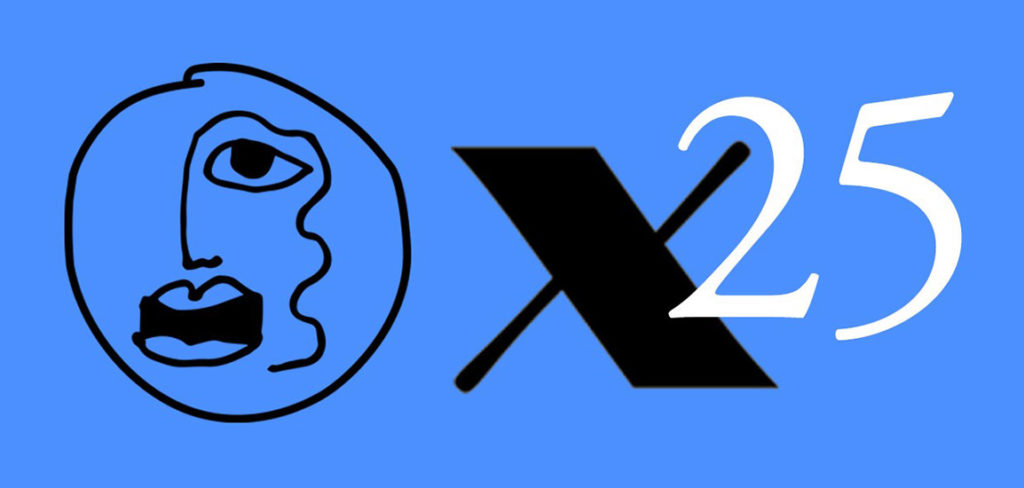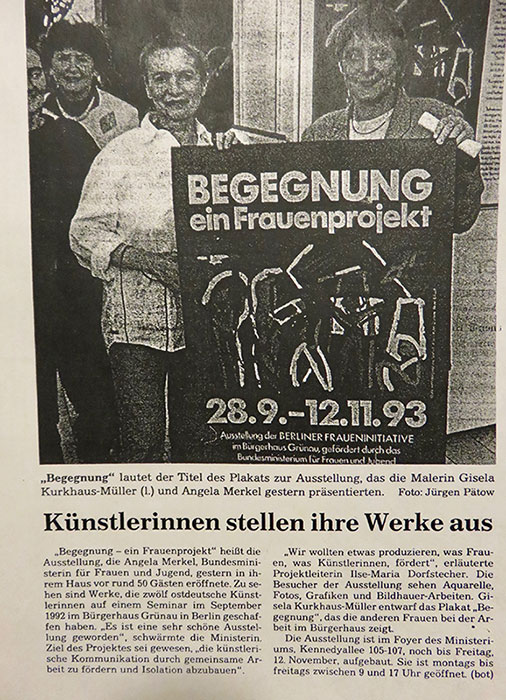A merger of female artists from the East, who wanted to make themselves heart clearly in the reunified Germany after the end of the GDR and took over the Inselgalerie as a project two years later, has become a European and internationally oriented artist support.
Image above: Exhibition opening in the Ministry of Women in Bonnon September 28th, 1993, with Gisela Kurkhaus-Müller (left) and Minister Angela Merkel
For exactly 25 years, the Berlin women’s initiative Xanthippe e. V. for female positions in the galleries and museums. 2018 marks the foundation of the non-profit association for the 25th time. The members of the association today include artists, scientists and friends of the gallery from all over Berlin.
Exhibition series for the anniversary
In the second half of 2018, the artists of the association will present their own works and those of their own chosen partner in a series of three-week exhibitions titled “X25”. They are also exhibition makers. Elli Graetz is the first Xanthippe to grab the baton. She presents Barbara Illmer and hands over to Gisela Kurkhaus-Müller on October 18th, who has chosen the sculptor Anja Spitzer as her partner.
The other X25 exhibitions (the “Xanthippen” are mentioned in the list first.)
September 20th to October 13th, 2018: Brigitte Denecke & Yang Sa You
October 18th to November 10th, 2018: Gisela Kurkhaus-Müller & Anja Spitzer
November 15th to December 8th, 2018: Sonja Blattner & Jill Tegan Doherty
December 13th to January 12th, 2019: Rosika Jankó-Glage & Susanne Schill
The X25 season will continue in the second half of 2019 until the 25th anniversary of the Inselgalerie.
The history of the non-profit Berlin artists initiative Xanthippe e. V.
In the fall of 1992, 12 artists met at the Bürgerhaus Grünau under the direction of the theater and art scholar Ilse-Maria Dorfstecher to form a plein air. What all had in common was that they came from the GDR and were faced with the question of how they can secure their existence through artistic creation in the future as well. Projects like the Pleinair were opportunities to develop common strategies.
Sculptors Marguerita Blume-Cárdenas and Emerita Pansowová, the painter and graphic artist Nuria Quevedo, the graphic designers Ursula Strozynski, Elli Graetz and Gisela Kurkhaus-Müller, and the writer Annett Gröschner were among the participants. The artists created sculptures, pictures, drawings and texts. The resulting works were presented the following year under the title “Encounters I” at three exhibition venues, i.a. in the Ministry of Women’s Affairs in Bonn. The then Minister Angela Merkel opened the exhibition.
Parallel to these activities Ilse-Maria Dorfstecher founded the artists’ association Xanthippe e. V. The name Xanthippe “symbolizes the will of the founders to do something about the prejudices that are still attached to self-confident, dedicated women and their technical skills. Consequently, the intention of the association is to work for more consideration and recognition of the performance of female and male and female scientists … “This is what the founders say in a statement. Two years later, in 1995, the Xanthipps, led by Ilse-Maria Dorfstecher, took over the Inselgalerie in Inselstraße 13 in Berlin-Mitte. In the beginning, male artists occasionally exhibited on the side of women. When asked why the Inselgalerie finally became a gallery of artists, Ilse-Maria Dorfstecher answers: “There were just a lot of very good applications from women. The Western artists came and we found that their situation was no better than ours. “
To offer many artists a public platform, double exhibitions with relatively short terms – up to four weeks – have been agreed. With this concept, the Inselgalerie has remained until today. In the rooms of the gallery not only exhibitions were shown, but also a program of readings, talks, lectures and concerts. This too was and still is predominantly denied by women today.
Thanks to an annual sponsorship by the Berlin Senate, the untiring commitment of the founder of the association and a large number of helpful friends, the Inselgalerie still exists today, now already at the third exhibition venue in Berlin-Friedrichshain. The location in Inselstraße had to be abandoned in 2002. The gallery owners received an interim contract for the ground floor rooms at Torstrasse 207, which had to be vacated in the spring of 2017 due to extensive modernization measures. The gallery is currently recording a former Sparkasse on Bersarinplatz.
Among the exhibition highlights from 25 years include “Rheintöchter-Sproadöchter” in 1996, “Neighbors” – a project with Polish artists 2013, “Teresa of Avila – mysticism and transgression” with 20 artists from 10 countries in 2015 and the two Exhibitions “Wieder im Licht I” 2013 and “Wieder im Licht II” 2014, reminiscent of forgotten artists who were marginalized during the Nazi era. In 2018, the gallery reverted to tradition with “Wieder im Licht III”.
In 2007, Ilse-Maria Dorfstecher was honored with the Berlin Women’s Prize “for her promotion and networking, exhibition and announcement of artists in Berlin. A special merit lies in the rediscovery and appreciation of female artists, who were forgotten by the breaks in German history as well as by the male-centered reception of the art business. “
In the summer of 2017, Eva Hübner took over the Inselgalerie and was elected to the board of the association. Ilse-Maria Dorfstecher retired due to age from the management of the gallery, but remains a member of the board of the association.

Is the artist gallery still cool enough?
The situation of women in the visual arts has undoubtedly improved in recent years. Nevertheless, the art market, the decision-making levels of museums and galleries are still male-dominated. Work remains to be done for the xanthipps.
But is an artist gallery still attractive for young artists who want to attract attention in the international art scene? Born in 1970, Juliane Ebner, who exhibited several times in the Inselgalerie, responded to this question in the Tagesspiegel interview in the summer of 2017:
“I’m exhibiting here, although it’s a women’s concept, I have to say honestly. I have to be strong enough and, above all, cool enough to exhibit in a women’s gallery … This is where GDR heroines of my mother generation such as Emerita Pansowová and Nuria Quevedo exhibited. Such names stand above any derogatory term as ‘women’s shop’. “
It is important to continue traditions and win new “heroines”. In the anniversary year of Inselgalerie 2020, a documentary about the effectiveness of the gallery from its foundation to today is planned and a symposium on the question: “Women’s Gallery – Chance or Stigma?”
Event in September 2018
WORKSHOP READING – Andra Joeckle reads from her manuscript “Blauer Oleander”
Thursday, September 13th, 2018, 7 pm
After being bitten by a tick, painter Ragna explores the characteristics of this insect. She is awed by the amazing ability to survive of this organism and wishes to be endowed with such talents.
Andra Joeckle, born in 1967, is a writer, radio author and literary translator. Her radio play “Die Zecke” was already broadcast in 2017 in Deutschlandradio Kultur. Now the novel “Blue Oleander” is created from the material.
Admission: 5 / reduced 3 euros
http://www.andra-joeckle.de
Elli Graetz und Barbara Illmer – Graphics / Plastic Installation
X25-1: fantastically complicated
248. Exhibition of Inselgalerie Berlin, 23rd August – September 15th, 2018
Opening: August 23rd, 2018, 7:30 pm
The landscape and figure of Elli Graetz are clearly and simply evolved from the structure of the material. Barbara Illmer’s intensely colored, paper-based sculptures with spikes or protective nets create a lively contrast.
KABINETT 2: Gudrun Wendler „Black’n blues – Images and Books”
Opening: August 23rd, 2018, 7:30 pm, until September 15th, 2018
Gudrun Wendler is an extremely versatile artist. She paints, draws, prints, photographs and writes poetry. She first completed a degree in art education in Bonn and then sought her teacher of the liberal arts. These were the draftswoman Sophia Vari-Botero in Paris and Alexander Bogen in Tel Aviv. After years of long stays abroad, ia. in New York, Moscow, Dublin, Paris and Tel Aviv, the artist settled in Berlin in 2005.
At first, the predominantly abstract artist examined the possibilities of color and achieved a strong, pulsating expression in her large-format, monochrome surfaces. For the formal language, she preferred the black and white of the graphic. In the small-format artist’s books she finds the synthesis of both techniques. In recent years, Gudrun Wendler has also painted objectively and discovered some printing techniques.
In the cabinet exhibition “Black’n Blues-Bilder und Bücher” she presents u.a. an eponymous series of woodcuts in front. She also shows older works and her artist books.
Opening hours
Tue-Fri 2 – 7 pm
Sat 1 – 5 pm
WHERE?
Petersburger Straße 76A
10249 Berlin-Friedrichshain (At Bersarinplatz)
www.inselgalerie-berlin.de






